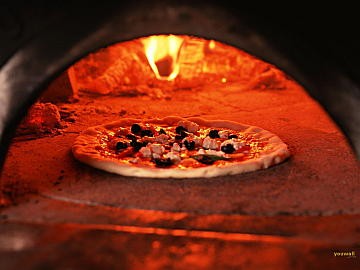Pizza ovens that burn biomass briquettes.

News16 de July de 2025
A good pizza is an almost universal choice. And when the advertisement says that the dough is made in a wood-fired oven, the "mouth-watering" is immediate. What few people know, however, is that wood is no longer a certainty inside the oven.
And it is increasingly likely that your pizza is being baked in a sugarcane-fired oven. In São Paulo, land of pizzerias and sugarcane, the use of bagasse already accounts for the largest use in these establishments. In Pernambuco, the small bricks of this residue are also beginning to establish themselves. Called briquettes, this energy source ensures a use for the residue generated in the mills and offers a renewable and ecological energy source that can also be used in various markets. The flavor of the "round" pizza is only expected to increase.
Mechanical engineer and researcher at Embrapa Agroenergy in Brasília, José Dilcio Rocha, believes that the widespread use of sugarcane residues is just beginning. "Applications are in the early stages. But we have developed studies and created technological innovations that tend to further expand uses in cities and industries," he emphasized. The technology created by the institution was able to produce a sugarcane briquette with higher energy efficiency than wood itself. "Wood is one of the oldest biofuels in humanity. Perhaps that's why it is still so widely used. But necessity stimulates the search for a solution," he said, indicating an alternative for regions such as the gypsum pole of Araripe, in the backlands of Pernambuco.
In areas with difficulty accessing legalized wood, which have already suffered from deforestation like Araripe, the use of other biofuels has been driven mainly by cost. "Those who opted for gas had to invest a lot and still rely on distributors," the researcher emphasized. The ecological appeal of the initiative attracted entrepreneur Ricardo Domingos, who opened his first pizzeria in November last year. La Bonna Pizza, in Boa Viagem, markets itself using pressed sugarcane in the oven instead of wood. "We called a specialist from São Paulo and he introduced us to the novelty. It is very common there," he said. Ricardo purchases the product from a distributor who sells briquettes from all over the Northeast and found the economic benefit.
"If it's a gas oven, we spend 50% more than with briquettes. With wood, it's more expensive," Ricardo summarized. One of the pioneers in the initiative in Pernambuco was Osmar Demiquei, owner of Barazzone pizzeria in Piedade, who has been using sugarcane briquettes for eight years. According to him, the production from the mills and the scarcity of wood due to deforested areas was the combination that led him to adopt sugarcane. "Today, it has become complicated to obtain legal wood. There are reforested eucalyptus, but they are very expensive," he pointed out. While a ton of reforested eucalyptus costs, on average, R$ 300 per cubic meter, firewood costs between R$ 80 and R$ 75. "In a day, we use about 100 kilograms of briquettes, if it were wood, it would be a third of a cubic meter," he compared.
Those who approve and already use pressed sugarcane bagasse emphasize that the product favors the flavor, as it allows for even and quick cooking. Domingos pointed out that the wood-fired oven with briquettes reaches a temperature of 400°C to 500°C, while a gas model does not exceed 300°C. Another advantage listed by the researcher is that the briquette is unlikely to be without a suitable substitute. "In agriculture, a lot of residue is generated and all of it can be used in briquettes," he mentioned, listing residues such as rice straw, corn cob, lemon and orange bagasse. How about a pizza like that?